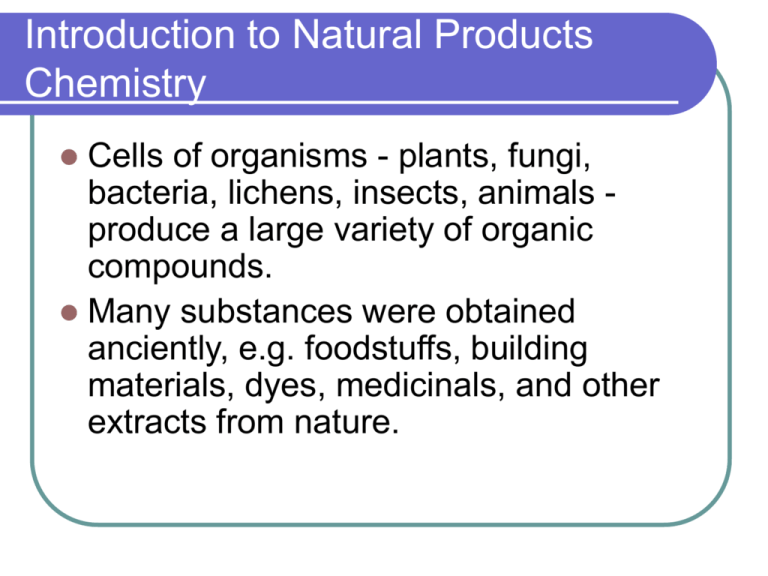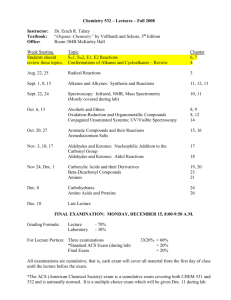Introduction to Natural Products Chemistry
advertisement

Introduction to Natural Products Chemistry Cells of organisms - plants, fungi, bacteria, lichens, insects, animals produce a large variety of organic compounds. Many substances were obtained anciently, e.g. foodstuffs, building materials, dyes, medicinals, and other extracts from nature. Introduction to Natural Products Chemistry Crude aqueous extracts of certain plants (and animals) provided pigments, such as indigo and alizarin. Introduction to Natural Products Chemistry Other examples of natural products: ephedrine from Ephedra sinica (respiratory ailments) tetrahydrocann abinol (marijuana)geraniol (rose oil) cinnamaldehyde (cinnamon)diallyl disulfide (garlic) Introduction to Natural Products Chemistry Mild heating of certain plants afforded perfumed distillates. Plants and animals have provided substances used for their biological activity, to heal or to kill, and form the foundation for folk medicine. Most natural products have usually come from plants and microorganisms due to practical difficulties in extracting them from animals. Introduction to Natural Products Chemistry Plants are particularly interesting because: They have the broadest spectrum of biosynthetic capability, and produce a wide variety of compounds. They use simple starting materials: water, carbon dioxide, nitrogen (elemental and in salts), phosphorus compounds, and salts. Their biosynthetic paths are known Introduction to Natural Products Chemistry In the late 1700's, chemists moved from myth and mystery to basics of modern scientific methods to begin to uncover the true properties of natural extracts from biological systems. They discovered that natural extracts had more complex compositions and properties than salts and minerals. Introduction to Natural Products Chemistry This lead Berzelius, in 1807, to distinguish between "inorganic" and "organic”;("Organic" substances were believed to be obtainable only from organs of living systems and could not be man-made because only living systems have the vital ("life") force. "Inorganic" materials were from non living, e.g. mineral, sources.) In the 1800's, organic chemistry was exclusively the study of natural products. Introduction to Natural Products Chemistry Natural extracts were subjected to separation into component compounds, which were then purified and analyzed. In the late 1800's, synthetic methods were being developed for some of these natural compounds. Some examples of natural products and when they where discovered are as follows: Introduction to Natural Products Chemistry morphine (narcotic analgesic) 1817 Introduction to Natural Products Chemistry strychnine (poison) 1818 Introduction to Natural Products Chemistry cocaine (narcotic stimulant) 1859 nicotine (toxic) 1828 Introduction to Natural Products Chemistry General isolation strategy of natural products: Introduction to Natural Products Chemistry Extract the dried and ground plant material with a suitable solvent. Concentrate the extract. Separate and purify each component. Since the concentrate contains an enormous variety of compounds, early isolations involved selective crystallization of the most dominant component in the mixture. Liquid natural products were distilled. Natural organic acids were isolated by aqueous basic extraction and natural organic bases (alkaloids) were isolated by aqueous acidic extraction. Introduction to Natural Products Chemistry Modern chromatographic methods have been greatly developed to isolate and purify a large number of different compounds in very small quantities: column, GC, TLC, HPLC, paper, electrophoresis, ion exchange, etc. Natural products are usually given names that are derived from the species name of the plant or animal, or from the biological action, or property, of the compound. Introduction to Natural Products Chemistry In the late 1800's, natural products were identified and analyzed by mp, bp, [a] (optical rotation), hoping to find correlations between data and structure. This initiative was not successful in predicting structure, but useful data on natural products were obtained. Introduction to Natural Products Chemistry Classical structural elucidation is done by: Determination of functional groups Determination of the carbon skeleton and the location of the functional groups Degradation to smaller fragments (A-B-C ------> A + B + C) Elemental analysis Reactivity (leading to new reactions) Stereochemistry Synthesis of the smaller fragments (A, B, C) and the entire molecule (A-B-C) Classification of the compound into a biogenetic family of compounds Introduction to Natural Products Chemistry More modern structural elucidation and characterization by spectroscopy: 1930's UV (ultraviolet) light (cf. Woodward's Rules, 1941) 1940's IR (infrared) spectroscopy (note: penicillin structure problem in W.W.II) 1950's NMR (nuclear magnetic resonance) spectroscopy 1960's MS (mass spectrometry) ESR (electron spin resonance) spectroscopy and by other methods: ORD (optical rotatory dispersion) CD (circular dichroism) acidity and basicity measurements (pK) advanced synthetic and biosynthetic technology X-ray crystallography Introduction to Natural Products Chemistry Modern methods reduces the necessity of chemical degradation methods, so much less material is required. Why synthesize natural products? Structure determination Challenge Develop new synthetic methods Practical and commercial interests







